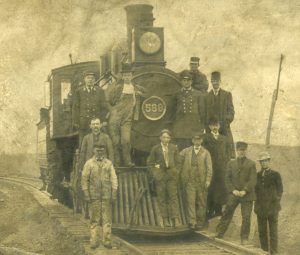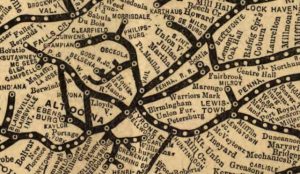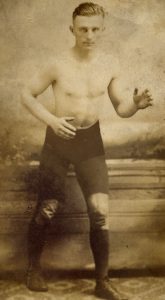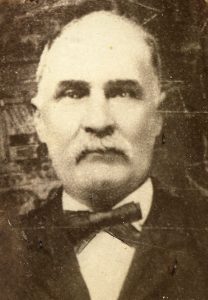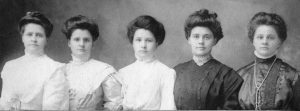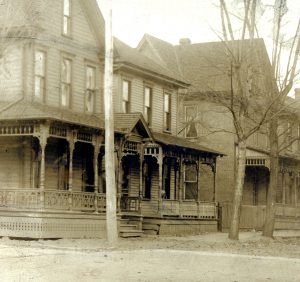George Shank of Hummelstown was a weaver who died in 1826 leaving a wife Maria and eight children. Two of the children named in his will were Elizabeth and George, who were probably the two of that name who appear in Huntingdon County by 1820. The elder George signed the will on the 28th of February 1826; it was probated on March 27. He was obviously in his final illness when he wrote it.1
He left several pieces of real estate: two lots on Market Street and a tract of woodland in West Hanover.2 Maria was to have the use and occupancy of the house, and any profits from it, as well as the woodland tract. She was also to have the choice of the four beds, with the bedsteads, also the tables, kitchen dresser, stove from the dining room, eight chairs, a spinning wheel, the family Bible, a prayer and hymn book, as well as a cow, and all the beef, tallow, flax and tow linen in the house. After her death the real and personal property was to be sold to pay the debts, and any remainder was to be shared equally among the children. The exception was the son David, who was to have the weaver’s loom, which was not to be deducted from his share of the estate. A trusty friend Frederick Hummel was the executor.
The will suggests that George was prosperous, since he owned the real estate. It suggests that Maria would continue to receive an income from the house or the woodland. There is no mention of selling anything to pay debts until after her death.
It is believed that this George served in the Lancaster County militia, Seventh Batallion, the same company that a Daniel Conrad served in.3 This could be the father of Elizabeth Shank’s future husband, also named Daniel Conrad.4 It is important to be cautious, however, since there were other Shank families around, and even other men named George Shank. A different George Shank married Maria Brandt; they had children baptized at Hummelstown Lutheran Church between 1804 and 1819.5 These are later than the children of George and Maria of Hummelstown. Perhaps the Georges were cousins. Nothing definite is known of the parents of George the weaver.6
Children of George and Maria (the one who died in 1826):7
Elizabeth, b. 1775, d. 1853, m. Daniel Conrad, lived in Huntingdon County
John, b. 1776, d. Aug 25 1836, m. Mary Bower (1781-1839), bur. at Hummelstown Zion Evangelical Lutheran8
Nancy
Catherine
George, b. Nov 1786, d. June 1868 in Warriors Mark, Huntingdon County, m. Nancy Funk, had a large family9
Jacob, moved to Centre County, at least 3 children10
David, b. 1802, d. 1864, buried at the Old Cemetery, Hummelstown Zion Lutheran Church11
- Dauphin County Will Book D, 1812-1847. ↩
- He bought the land in 1813 from George Bagastow or Bagastoss for 55 pounds. (W. Mills Davis, History of the Davis, Eichelbarger… Families, 1911. Davis gave the name as Becastora, which was some clerk’s rendering of Bagastow. Bagastow died in 1844 and is buried in Hummelstown (FindaGrave). ↩
- W. Mills Davis. ↩
- A story was passed down in the family that Daniel Conrad and his wife Elizabeth Shank were first cousins. Without more information it is impossible to say. (Ref: W. Mills Davis) ↩
- They had a daughter Elizabeth, born in 1804. ↩
- He can’t be the son of George Shank of Lancaster County who died in April 1777. His children were listed in birth order in an Orphan’s Court record in 1784. He did have a son George (with his second wife Maria Margaretha Friedel), probably born in 1763, but this is too late to be the George of Hummelstown, who was having children by 1775. It could be the George who married Maria Brandt. ↩
- Assuming that Elizabeth and George were the ones who moved to Huntingdon County. The dates for John and David are from burials at Hummelstown Zion Lutheran. ↩
- Online at: http://www.rootsweb.ancestry.com/~padauph2/hummelstownzion.html ↩
- He was in Warriors Mark, in the census of 1820 though 1840. There are mentions of his family in Nearhoof, Echoes from Warriors Mark, but it is not always clear whether they refer to the father or his son, also named George. After his death letters of administration were granted to his son Martin. (Huntingdon County Wills & Admins, book 6, p. 295) ↩
- In the 1850 census there were two Jacob Shanks in Centre County, one born about 1768 and one in 1796. Either one could possibly fit in here. ↩
- Online at: http://www.rootsweb.ancestry.com/~padauph2/hummelstownzion.html ↩

